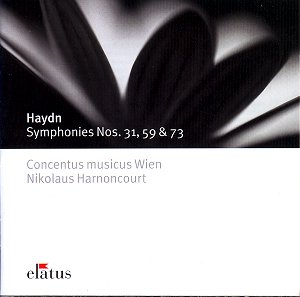Haydn intended to make a big effect with the
opening of his Symphony No. 31, with its four braying horns, and
Harnoncourt and his orchestra achieve everything that he could
have wished for: thrilling, sounding forth in glorious vulgarity.
This Allegro movement - as well as the others
recorded here - is notable for its directness and vitality, as
the performances make the most of the contrasts with the music's
more lyrical aspects. The degree to which this is done may be
a source of worry for some listeners, although the option is there
in the score, with the exception of the occasional liberty.
The slow movements of all three symphonies are
carefully and lovingly shaped for maximum lyrical effect. There
is always a painstaking attention to detail, enhancing the contrasts
of dynamic shading, for example. Added to that, the standard of
playing is particularly high, but with an 'original instrument'
set of performances it is the more surprising that there is no
keyboard continuo. In the symphonies of this period in the composer's
development, the continuo always adds an extra dimension to the
texture, and its absence can therefore only be a source of regret.
Harnoncourt observes repeats more scrupulously,
helping to achieve an appropriate balance of structure. In the
Hornsignal Symphony, there are abundant solo opportunities among
the orchestra, and these are played with style and panache. In
this regard this is as good a performance as any in the catalogue.
There are a few other caveats, however. Harnoncourt
tends to overdo the contrasts of tempo within the symphonies,
and this is at its most controversial in the minuets and trios,
as though he thinks that Haydn had under-characterised the music.
The Presto tempo in the first movement of the Fire Symphony is
very fast indeed, risking issues of articulation. At the other
extreme, the second movement, which is labelled Andante piú
tosto allegretto, should surely be taken faster than the sluggish
tempo adopted. The phrasing seems exaggerated too.
The recorded sound for all three performances
is helpful, spacious and vivid. Although the reverberation is
ample, the effect adds to the atmosphere and the richness of the
orchestral sound. While there are some questions raised about
some aspects of the performances, in most respects this disc offers
the listener many rewards.
Terry Barfoot
